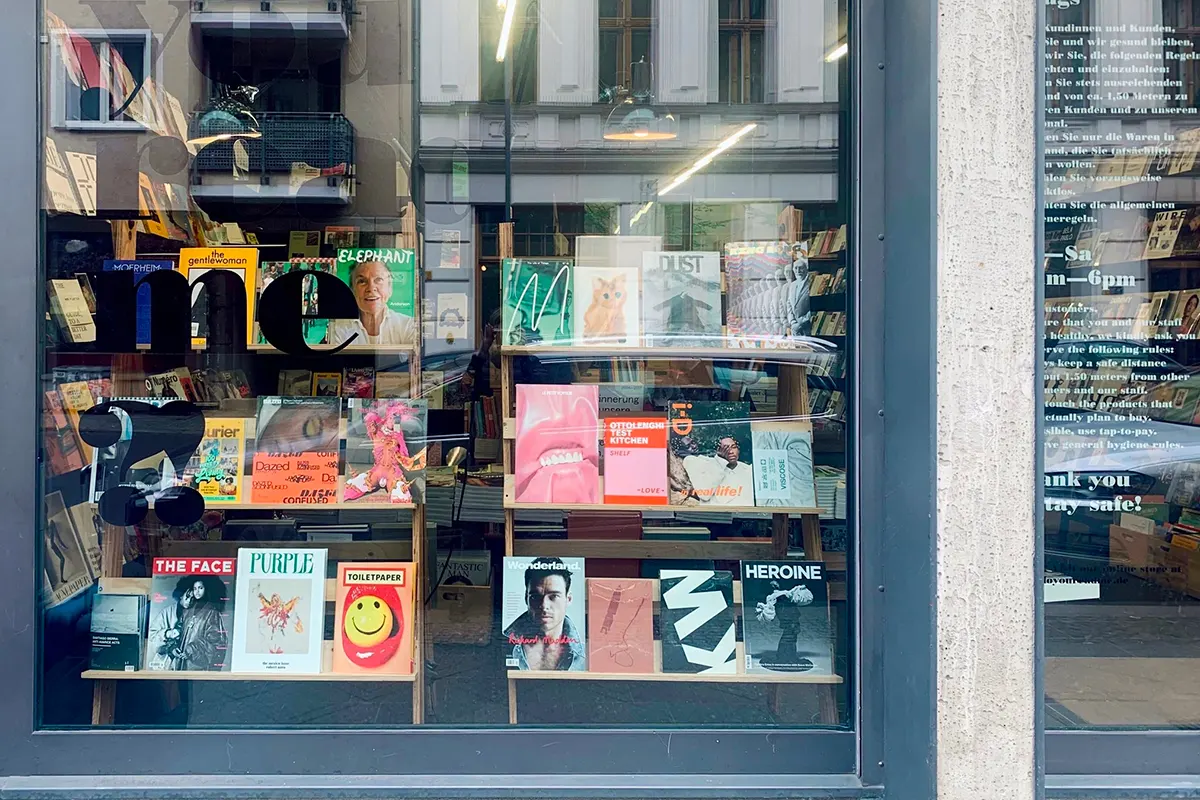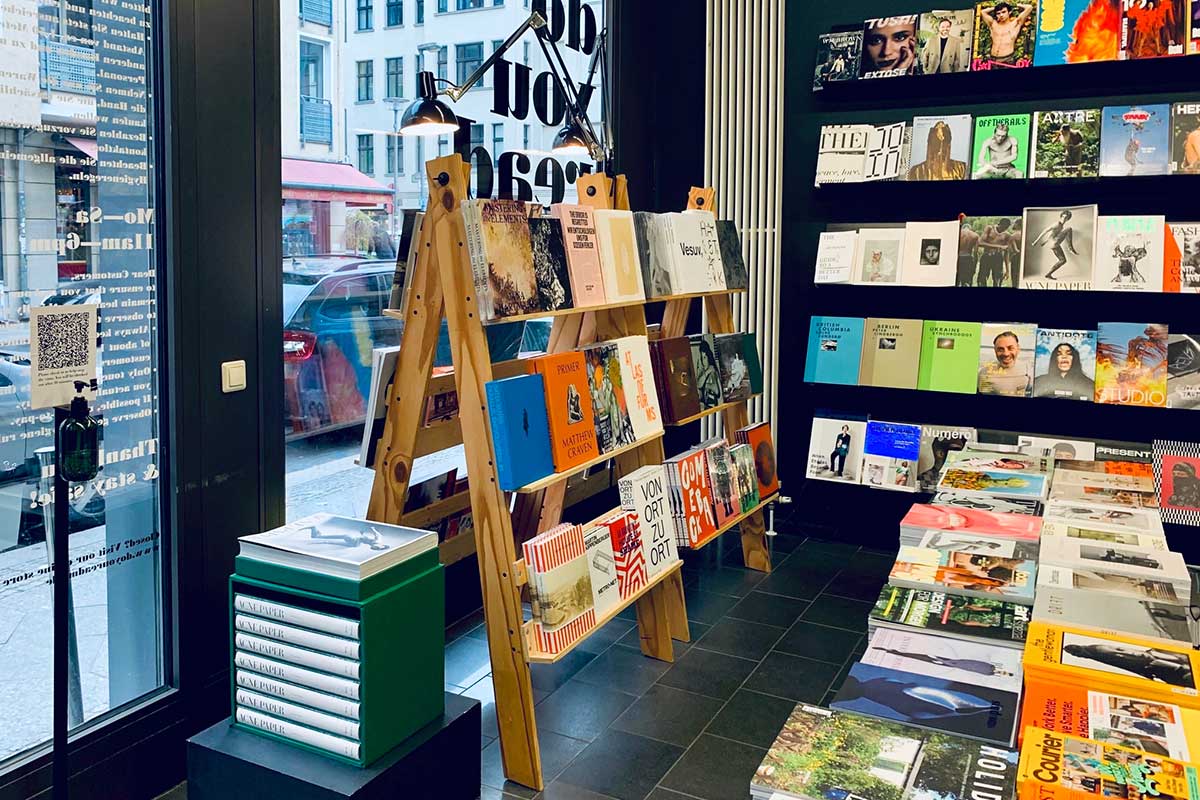A few square meters for about 2,000 titles in the ‘locus amoenus’ of art. Do You Read Me?! was founded in 28 Auguststraße by owners Jessica Reitz and Mark Kiessling.
Do You Read Me?! Berlin
Ms. Reitz, who was already a bookseller, comes from the world of culture and theater; Mr. Kiessling has a background in design. After graduating from the Köln International School of Design, in 2001 he founded the Greige Design Studio, specializing in interior decoration.
Before that, he designed concept store interiors for Adidas in Berlin. The idea of creating a place for holding readings, gatherings and events that revolved around a defined brand, recognisable from its interior design to the logo on its shopping bags came after «sold to customers from all over the world who like the logo and who don’t even know what we do». The store is just a few square meters, with a display window by the entrance and another one on the other side, facing a small courtyard.
Do You Read Me?!: A Hub of Culture and Commerce in Berlin’s Auguststraße
«We have a good supply of natural light,» says Kiessling, «but the wall space available to display all the publications is limited to just two walls. We installed several rows of standalone shelves, which I designed with my Berlinese friend and product designer Rupert Kopp, in order to exhibit as many magazines as possible, to cover all the walls». On the floor, benches thrifted from Berlin’s hinterland flea markets display more merchandise. The counter is made out of plywood. On the street-facing window, there are another two displays, designed by Kiessling six years ago for the Design Miami/Basel show.
The Auguststraße is a locus amoenus for this type of activity, given the presence of dozens of art galleries and workshops. This creates customer traffic in tune with the business and editorial offering of Do You Read Me?!, Berlin is furthered by the Hackescher Höfe area, where several mono-brand stores have opened in recent years, turning it into a destination for tourists who are looking for more than just shopping.
Do You Read Me?!: A Curation of Publications for Every Passion
The arrangement of the publications available at Do You Read Me?!, Berlinchanges continuously, following the owners’ policy of placing new titles next to established brands. «Our clientele is heterogeneous,» says Jessica Reitz from her place behind the register, «local students, tourists, professionals, art lovers, photography lovers, design, fashion and genre literature lovers…». The selection, about two thousand titles, is the result of the passions and subjectivity of its curators, «to the point where it seems arbitrary,» Kiessling points out.
In addition to some more well-known titles, ones such as the Belgian art and architecture magazine Accattone, published by architects Sophie Dars and Carlo Menon, the first issue of the new Bellissimo Zine by photographers Paolo Zerbini and Ivan Ruberto—a photography project that investigates man and his places of belonging—and travel magazines like Lost, Migrant and The Travel Almanac. For literature, The Happy Reader, Cheese, or the collection of texts How to Be Invisible, by Kate Bush.
Potsdamer Straße Haven: A Bookstore, Reading Lounge, and Art Exhibition Space
Seven years ago, a new space opened its doors: a bookstore and reading lounge holding art exhibits on 98 Potsdamer Straße, near the art galleries and Andreas Murkudis’ concept store. Unlike Do You Read Me?!, Berlin on the Augustraße, here the focus is more on books than magazines, but the topics remain the same. The entire space is divided into two areas—a bookstore and a reading lounge with a long, spacious table. The interiors were designed in collaboration with Artek, a Helsinki-based furniture manufacturer—who created a series of self-assembling chairs made of pinewood boards based on the 1974 prototypes by the Italian designer Enzo Mari.
They can be assembled in twenty minutes using only nails and a hammer. On the walls is the What Do You Read? project, a space dedicated to celebrities in the worlds of art, culture, design and fashion who were asked to provide a reading list of personal favorites. The result is a kaleidoscopic wall of images and covers, about three hundred titles recommended by twenty-six famous figures.
The District of Do You Read Me?!, Berlin
The prayer hall of the Neue Synagoge on Berlin’s Oranienburger Straße can accommodate up to three thousand people – the largest synagogue in the city. Built in the second half of the nineteenth century by architect Eduard Knoblauch, it was vandalized in 1938 during the ‘Night of Broken Glass.’ It was almost completely destroyed in 1943 when Berlin was bombed and was again partially demolished in 1958 by the GDR. Today, only the facade and the Moorish Revival dome remain, restored between 1988 and 1993.
The size of the structure bears witness to the population growth of the neighborhood in which it is located: Scheunenviertel, in the Mitte area. Migration waves had led Jewish communities from Lithuania, Poland, and Ukraine here, by order of Emperor Frederick William I of Prussia. The neighborhood was at the time considered as the outskirts – the name dates back to its original purpose as a granary (Scheunen) outside the city walls. The barns once stood where the triangular square of Rosa Luxemburg Platz is now located, and the hay was sold at the market on today’s Alexanderplatz.
From Degradation to Artistic Resurgence
Ever since the industrial revolution, the Scheunenviertel has been one of the poorest neighborhoods in Berlin. Babelsberger Platz—which was soon renamed Bülowplatz—and, in 1890, the Volksbühne theater, were built as part of a program to combat the degradation of the neighborhood. The Babylon Cinema was built in 1929. Under the Nazis, Bülowplatz went through several name changes; the one it has now, Rosa Luxemburg Platz, was chosen only after the end of the war when the socialist regime of the GDR opted for naming the square after the Polish-born philosopher who became a naturalized German citizen. When the Wall was erected, the Scheunenviertel, like all of Mitte, remained in the Nazi and war-torn East.
After 1989, the reunified government formulated an urban rehabilitation plan. A building that benefited from this plan was the Tacheles, which boasted late-Gothic elements and neo-Renaissance ashlars, near Friedrichstraße and Oranienburger Straße. Conceived as an attempt by the German entrepreneur Otto Markiewicz to build a shopping mall similar to the Printemps in Paris or Harrods in London, the Tacheles has worn many hats in the last century: first as a showroom and repair service for the first AEG house appliances, then under the Nazis as a television studio, and eventually as the headquarters for the Central Command of the SS, and as a place to imprison POWs and political dissidents.
Under the GDR it became the venue where trade union meetings were held. A few months before the fall of the Wall, a complete demolition had been planned for April 10, 1990. However, on February 13 the entire structure was occupied by the first collective of artists to form a real organized initiative, which they called Tacheles, meaning to ‘speak frankly’ in Yiddish.
A Revived neighbourhood
The new reunified government invested into reviving areas such as the courtyards of the Hackesche Höfe, and renovating buildings that still bore the marks of the allied bullets. The gentrification of the Scheunenviertel and all of Mitte followed. Between the 1990s and the 2000s, the area gradually turned into a creative hotspot.
Galleries, workshops and studios opened their doors: among the first were the Eigen + Art galleries, also present in Leipzig; Neugerriemschneider, managed by Tim Neuger, one of the organizers of the Gallery Weekend review, showcases installations and performances by local and international artists in abandoned spaces, such as former factories or disused ballrooms; Kicken is a photography gallery on the Oranienburger Straße. On Auguststraße, the street of contemporary art galleries, is the Clärchens Ballhaus, a restaurant founded in 1913 by the Bühler family. It contains the Spiegelsaal (hall of mirrors), in which Tarantino shot one of the scenes from Inglorious Basterds.
Every two years, the Auguststraße also becomes the epicenter of the Berlin Biennale of Contemporary Art, hosted at the KW Institute for Contemporary Art, which was born in 1991 at the hands of Klaus Biesenbach — who also founded the Biennale in 1996, and is currently the director of the Museum of Contemporary Art in Los Angeles — together with a collective of young artists in a former margarine factory.
Do You Read Me?!, Berlin
Auguststraße 28, Berlin, Germany. Do you read me?! offers a select range of international contemporary magazines and reading material. The Berlin shop on Auguststrasse 28 boasts hundreds of magazines, themed journals and books from more than twenty countries with a focus on art, fashion, photography, design as well as architecture, literature, music, society and contemporary culture.




















